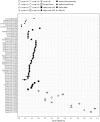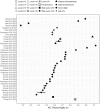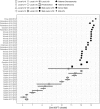Physical characteristics of players within the Australian Football League participation pathways: a systematic review
- PMID: 29260420
- PMCID: PMC5736505
- DOI: 10.1186/s40798-017-0109-9
Physical characteristics of players within the Australian Football League participation pathways: a systematic review
Abstract
Background: Australian football (AF) players require endurance, strength, speed, and agility to be successful. Tests assessing physical characteristics are commonly used for talent identification; however, their ability to differentiate between players across the Australian Football League's (AFL) participation pathway remains unclear. The objective of this review was to quantify the physical characteristics of male AF players across the AFL participation pathway.
Methods: A search of databases was undertaken. Studies examining tests of physical performance were included, with 27 meeting the inclusion/exclusion criteria. Study appraisal was conducted using a checklist of selection criteria.
Results: The 20-m sprint time was the most reported test, followed by vertical jump (VJ), AFL planned agility, and 20-m multi-stage fitness test (MSFT). The fastest times for 20-m sprint were for Elite AFL players (range 2.94-3.13 s), with local-level players the slowest (3.22-4.06 s). State Junior Under (U) 18s (58-66 cm) had higher jumps than senior players, with the lowest jumps reported for Local U10s (mean 31 cm). No elite-level data were reported for the AFL planned agility or 20-m MSFT. AFL planned agility times were only reported for talent pathway levels, with large performance variability evident across all levels (8.17-9.12 s). Only mean 20-m MSFT scores were reported from Local U10s to National Draft Camp (6.10-13.50 shuttles).
Conclusions: Talent pathway players exhibit similar mean test scores irrespective of the physical test, with the exception of 20-m sprint and VJ. Physical tests can discriminate between local participation level players but are less useful within the AFL talent pathway.
Keywords: Australian rules football; Physical performance; Sport development pathway; Talent identification.
Conflict of interest statement
Authors’ information
Not applicable.
Ethics approval and consent to participate
All studies included in this systematic review reported that the ethics approval was obtained from an appropriate ethics committee.
Consent for publication
All studies included in this systematic review reported that consent was obtained from all participants regarding their participation and publication of data.
Competing interests
Jade Haycraft, Stephanie Kovalchik, David Pyne, and Sam Robertson declare that they have no conflicts of interest relevant to the content of this review. However, David Pyne and Sam Robertson were authors/co-authors of the eight articles included in the analysis.
Publisher’s Note
Springer Nature remains neutral with regard to jurisdictional claims in published maps and institutional affiliations.
Figures






References
-
- Burgess D, Naughton G, Hopkins W. Draft-camp predictors of subsequent career success in the Australian Football League. J Sci Med Sport. 2012; doi:10.1016/j.jsams.2012.01.006. - PubMed
-
- Coutts AJ, Quinn J, Hocking J, et al. Match running performance in elite Australian rules football. J Sci Med Sport. 2010; doi:10.1016/j.jsams.2009.09.004. - PubMed
-
- Dawson B, Hopkinson R, Appleby B, et al. Player movement patterns and game activities in the Australian Football League. J Sci Med Sport. 2004; doi:10.1016/S1440-2440(04)80023-9. - PubMed
-
- Wisbey B, Montgomery PG, Pyne DB, et al. Quantifying movement demands of AFL football using GPS tracking. J Sci Med Sport. 2010; doi:10.1016/j.jsams.2009.09.002. - PubMed
Publication types
LinkOut - more resources
Full Text Sources
Other Literature Sources

